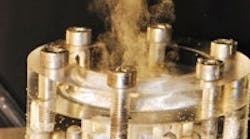A team of researchers at the University of Sheffield, U.K., believe they have developed an energy-efficient and inexpensive method using microbubbles that could replace traditional dissolved air flotation (DAF) for water purification.
The method came about as a solution to harvesting algae as a biofuel. Previously, there was no cost-effective method to harvest the algae from water so the algae could be processed effectively. The team, led by Professor Will Zimmerman in the Department of Chemical and Biological Engineering, found that using microbubbles can float algae particles to the surface of the water, making harvesting easier.
More details can be found in the January issue of Biotechnology and Bioengineering.
Microbubbles have been used for flotation before (see "Small Bubbles Offer Big Benefits"), but previous methods have been very expensive.
Compared to existing flotation systems, Zimmerman's solution uses up to 1,000 times less energy and is expected to be much less expensive to install.
"Conventional DAF uses highly turbulent flow generated from saturation of the liquid with gas at 6 bar, released at 1 bar, to nucleate bubbles of the scale of 50–70 microns. We expect to use 20–30 micron bubbles with off-the-shelf diffusers for larger scale studies in laminar flow," notes Zimmerman.
The researchers estimate out laminar flow at Reynolds number 10–100. In comparison, conventional DAF achieves Reynolds numbers 10,000 or higher. "The energy dissipation is proportional to Reynolds numbers in turbulent flows that I have taken as representative, hence the claim of two-to-three orders of magnitude less energy usage is a conservative figure," he says. "Any way you look at it, the energy used to create microbubbles in this range is negligible against conventional systems that push liquid," he adds.
Zimmerman also points out the relatively cheap capital cost of an industrial blower for microbubbles versus a saturator and large pumps needed in DAF.
In addition, the microbubbles boast performance advantages over DAF. They provide faster separation and are gentler, allowing the handling of fragile flocs. Moreover, they don't require use of recycled liquid or flocculants.
The team is working currently with Tata Steel, Scunthorpe, U.K., on a pilot plant to test the new system on an industrial scale. The trials will reveal more details on design and installation costs.
"We are rapidly moving to produce a large lab-scale microflotation device, as that should provide all the design information for any scale-up operation."
Zimmerman is convinced that the technology scales with the surface area of a diffuser (each vertical column is similar to a bubble column of the same height), and expects pilot-scale adoption of microflotation, replacing DAF in two sectors, "imminently."
The system also has no moving parts, resulting in low maintenance costs.
"The only wearing expected on a fluidic oscillator would be from small particulate matter entrained in the gas stream, but everyone puts filters on their blowers, as such particles are missiles when they hit the blades. So the fluidic oscillator would be expected to live longer than the blower! The best performing diffusers we have found with our system are off-the-shelf ceramics. Because of the pulsation of the gas flow, you would not expect fouling to be a problem. The ceramics in our TataSteel trial were squeaky clean after three weeks of growing 'pond scum!' It is really hard to imagine what would need maintenance," Zimmerman enthuses.
One issue Zimmerman foresees is setting up automatic control systems, as current R&D work uses manual control systems. However, he adds, "fluidic oscillators are cheap and can be produced on just about anyone's CNC machine for what we need. We are developing larger ones for up to 8-in. pipe that you get in wastewater aeration, and high throughput. So far, the limitations have turned out to be the size of our compressors!"

